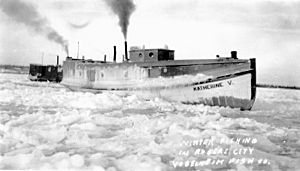Besser Museum for Northeast Michigan facts for kids
The Besser Museum for Northeast Michigan is a community museum in Alpena, a city on Lake Huron in the U.S. state of Michigan. The museum's goal is to protect and share the history and culture of Northern Michigan and the Great Lakes area. It even has its own planetarium!
The museum is the only accredited museum in Northern Michigan, which means it meets very high standards. It is known for having one of the best collections of Great Lakes Native American artifacts in the country.
Contents
What's Inside the Museum?
The Besser Museum is a large building with over 47,000 items in its collection. When you walk into the lobby, you can see a two-story Foucault pendulum, a special pendulum that shows the Earth is rotating. The museum also has a planetarium with a full dome screen where you can watch shows about the stars and space.
Avenue of Shops
One popular exhibit is the "Avenue of Shops," which recreates what a street looked like in the 1890s. It features 12 historic shops, including a pharmacy display. You can see old medicine bottles and other items that a pharmacist would have used long ago.
Art Collection
The museum has an impressive collection of fine art. It includes works by famous artists like Paul Cézanne, Pablo Picasso, Pierre-Auguste Renoir, and Diego Rivera. There is also a beautiful glass sculpture by Dale Chihuly.
Concrete and Invention
The museum was started with a gift from Jesse Besser, who founded the Besser Company. His father, Herman Besser, was involved in making cement. In 1904, Jesse invented a machine that could make concrete blocks by hand. This was a huge step forward for the building industry.
The original Besser block machine is on display at the museum. The Besser Company is still a world leader in making this type of machinery, and its main office is in Alpena.
Outdoor Exhibits
The museum sits on an 8-acre campus with outdoor exhibits and historic buildings.
Lafarge Fossil Park
A fun outdoor area is the Lafarge Fossil Park. Here, you can dig for real fossils from the Devonian Period, which was about 416 to 358 million years ago. This time is often called the "Age of Fishes."
The fossils found here are from a time when most of the Earth was covered by oceans. One of the most fearsome fish from this period was the Dunkleosteus. This giant predator could grow up to 33 feet long and had a head covered in bony armor instead of teeth. A large mural of the Dunkleosteus, painted by artist Judy Dawley, is on display near the fossil park.
The Katherine V Fishing Tug

The museum is part of the Great Lakes Fisheries Heritage Trail. It has exhibits about commercial fishing, sport fishing, and the ecology of the Great Lakes.
A main attraction is the Fishing Tug Katherine V, a historic wooden fishing boat. It is believed to be the last wooden fishing tug of its kind. The Katherine V spent its entire career fishing on Lake Huron. In 1931, it famously helped rescue another tug that was trapped in thick ice. The boat is so important that it was added to the National Register of Historic Places in 2003.
Planetarium and Special Events
The museum's planetarium was updated with a modern digital system. This allows it to show amazing movies and presentations about the universe on its dome-shaped ceiling.
The museum also hosts fun events. During the "Fall Harvest Festival," visitors can enjoy fresh apple cider and doughnuts. At Christmas, the museum displays a huge collection of decorated Christmas trees that were gifted from the former Alpena Mall.
Visiting the Museum
There is a fee to enter the museum. However, one artifact is on display for free outside: the giant bow anchor from the SS Pewabic. This steamship sank in a tragic accident on Lake Huron in 1865.

